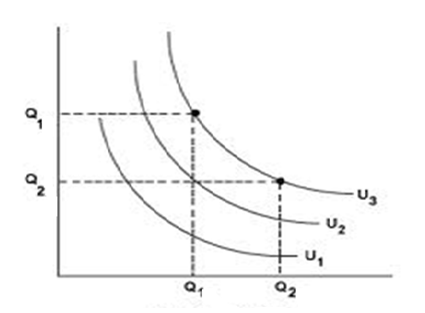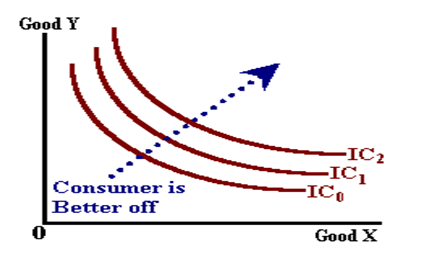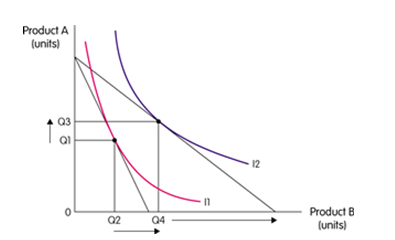Introduction
The protection of consumer welfare is a critical government initiative. There are notable economic challenges associated with low income families. Therefore, policymakers must consider the implementation of workable economic strategies. This is vital in creating price and demand equilibriums (Arnold 2010, pp. 10).
In a typical economy, various consumers depict diverse preferences for various goods. It is vital to comprehend how policies have implications on the prevalent market trends. It is necessary to analyze the consumer behavior and preferences within specific economies.
This paper presents a practical approach to policy implication on the purchasing trend within the market. The paper applies a hypothetical approach, with the analysis of the preference trend of goods X and Z.
The Household Preferences over the Two Goods with Similar Policy Implications on the Household Items In Terms Of the Utility and Level of Consumption of the Two Goods
Convex indifference curves are extensively used in the analysis of economic policies. In this scenario, the assumptions on the hypothetical goods are indicated. Good X is measured along the horizontal axis. On the other hand, good Z is measured along the vertical axis of the convex curve.
The two policy options can be analyzed from the convex curve. The concept of “diminishing marginal utility” dictates the nature of the convex curve to be applied in the analysis (Fakhrul Islam & Jabbar 2010, pp. 26).
In establishing the appropriate household preference for the two goods, the rule of “diminishing marginal utility” may be applicable. The first policy advocates for the provision of the household with a voucher.
The voucher is exchangeable for a specific quantity of the good X. Observably, the second proposition advocates for the offering a supplement based on the income. This is to be sufficiently applied in buying the good of similar amount.
A normal household consumption preference is applicable for the realization of equal policy effect (Mceachern 2012, pp. 34). This relates to the utility and level of the consumption of the two goods. Given the two goods, X and Z, the household is able to define its preference.
Consequently, the household can arrange these preferences in an order. In this context, the preferences remain complete. The policies provide an equal stance and significance. The graph below indicates the action of normal household preference necessary for the equal action of both policies.

(From Gilbert 2004)
The Household Preferences over the Two Goods with Potentially Different Policy Implications on the Household Items In Terms Of the Utility and Level of Consumption of the Two Goods
To achieve this aim, the transitivity preference of the household is applicable. An important assumption can be drawn from this association. The disparity indicates that there is more preference for a particular good (Schotter 2009, PP. 45).
Therefore, it can be deduced that if X is preferred to Z, it is true that the household has a spatial preference. The transitivity preference condition is eminent in this association. The disparities on the impact of these two policies emanates from the differences in preference for the two goods, X and Z. When the household depicts a higher level of preference for a particular good, the other is likely to be diminished.
Alternatively, the less preferred good may be supplied in fewer quantities in the market. The law of “diminishing marginal utility” may be applicable in explaining the variances in customer preferences (Feldman & Serrano 2006, pp. 46).
Consequently, these have a potential impact on policy formulation. Policy makers recognize the importance of engaging public participation processes. There is a potential indication from a positive policy on the utility or consumption level of a specific good.
The basic implication is that most consumers prefer to utilize goods that have most preferred qualities. It is assumed that the household may be satisfied with any policy advocating for a particular good or product. The graph below indicates the state of preference in which the consumers are better off.

(From Gilbert 2004)
Explanation of the Possibility of Occurrence of a Substitute Effect Associated With Either of the Above Policies
Most markets are likely to experience a substitute effect. The impacts of substitute effects are always noticed in the demand of various goods. The effects of any transformation within the price encourage the clients to choose a particular good. These clients are more likely to purchase a specific good. This trend may be due to its reduction in price.
A consequent rise or increase in the price of goods is likely to cause a shift in the pattern of purchase (Mceachern 2009, pp. 59). There is bound to be an occurrence of a substitute effect within any market.
Therefore, within any typical economy, the consumers are more likely to buy goods that retail at very low prices. The interaction of substitution and income effect may also play an important role in the development of substitution. The income of the household may shift. This is due to eminent economic factors within the entire market.
Basically, substitution effect refers to the transformation on the consumption trend. Substitution effect may entail the alteration in the utilization patterns. This occurs as a result of a change notable within relative prices of goods within the market. This trend can be noticed in the action of various customers or clients.
This is always as a result of the eminent trends within the general market. There is an evident possibility of occurrence of a substitute for both of the products under context (Mceachern 2012, pp. 78). This can be due to several factors.
There are several factors that might lead to the emergence of this pattern. In the present era, various elements play a significant role in consumer behavior and preference. Therefore, there is a high possibility of occurrence of a substitute effect.
An Explanation Whether the Policies May Succeed At Both of the Goals
Ideally, it is notable that these two policies are not likely to succeed at both of these goals. The competing demand and supply are important factors within the general market. Ideally, there are many elements that determine the market equilibrium (Schotter 2009, PP. 71).
It is imperative to note that the diverse factors associated with market patterns are critical. The variances observed in the household preference are critical. Particularly, this is in the determination of the success of the two policies. Market conditions within any economy are susceptible to both external and internal factors. These factors interact to alleviate the possibility of existence of a perfect market
. Therefore, there is bound to be a state of disparity in the action of these two policies. The customer preferences are more likely to rule the market demand and supply trends. Apart from these, there are other external factors that may lead to the development of notable disparities. These include weather conditions, tastes, and prevailing fashion within a particular economy.
Income is an important factor in the determination of prevailing market trends. Generally, high or increased rate of income raises the demand schedule. Consequently, these have a positive impact on the level of supply. The equilibrium point denotes the critical point within any market.
However, even in equilibrium states, customers have the capacity to identify themselves with trendy and valuable products. There are other approaches that might be applied. Introduction of new products with lower market prices is possible. This approach is likely to shift the focus of demand within the market (Mceachern 2012, pp. 112).
Apart from this, there is a potential shift in the consumer interests within the general market. The introduction of the third good is likely to help in the shift in the basic centre of interest.
The preference includes one of the vital factors that dictate the prevailing market conditions. The graph below indicates the likelihood of occurrence of a substitute effect between the two goods. Consequently, this has significant impact on the policies.

(From Gilbert 2004)
Calculation of the Firm’s Cost Minimizing Input Combination and the Corresponding Level of Minimum Cost
It is supposed that the company is presently experiencing the conditions of a short-run. The firm also has a fixed level of K at 25 units. Therefore, the calculation of the firm’s minimizing input combination and the corresponding level of minimum cost is as follows:
Production function = Q = K0.5L0.5
Q = K0.5L0.5 = (8 X 0.5) X (4 X 0.5) = 2 X 4 = 8
Cost function
TC = FC + VC
FC = Q
FC = K0.5 X L0.5
FC = 8 x 0.5 X 4 x 0.5 = 8
TC – 8 + 24 = 32
Cost minimization
MC = MR (where MC represent marginal cost and MR represent marginal revenue)
MC = change in TC/ change in Q
TC = C X Q
25X4X8 = C X Q
Q = 800 – C
Q = (800 – C) C
TC = 800C – C^2
MR = MC
800 – C^2 = 32
800 – 32 = 2C
768/2 = 2C/2
C = 384 (minimum cost)
Q = 384 / 8 = 48 units (minimum units)
Calculation of the Input Combination the Firm Will Use In The Long Run and the Corresponding Level of Minimum Cost
Production function = Q = K0.5L0.5
Maximum units = 100
Labour cost =$ 8
Capital cost = $ 4
Total cost = 8×4 = 32 x 100 units = $3200
Total produce under the cost function
Q = K0.5 X L0.5 = 8
Minimum cost per unit = 3200/8 =$400
An Explanation Whether the Firm Can Experience Economies of Scale In The Long Run
The firm may not experience superior economies of scale in the long run. Basically, this is due to the observable differences within the unit cost variations (Schotter 2009, PP. 115). Important lessons can be drawn from the various outcomes of the calculations.
As shown, the minimum cost in the short run is $384. On the other hand, it is notable that the long run cost is $400. The obvious variances in these costs depict important lessons. Generally, there is an inferior match between the expenditure and the income.
List of References
Arnold, A 2010, Economics, South-Western Cengage Learning, Australia.
Fakhrul Islam, M & Jabbar, A 2010, Consumer preferences and demand for livestock products in urban Bangladesh, International Livestock Research Institute, Nairobi, Kenya.
Feldman, M & Serrano, R 2006, Welfare economics and social choice theory, Springer, New York, NY.
Gilbert, S, Microeconomic Theory. Web.
Mceachern, A 2009, Microeconomics: a contemporary introduction, Thomson/South-Western, Mason, OH.
Mceachern, A 2012, Economics: a contemporary introduction, South-Western Cengage Learning, Mason, OH.
Schotter, A 2009, Microeconomics: a modern approach, South-Western Cengage Learning, Mason, OH.